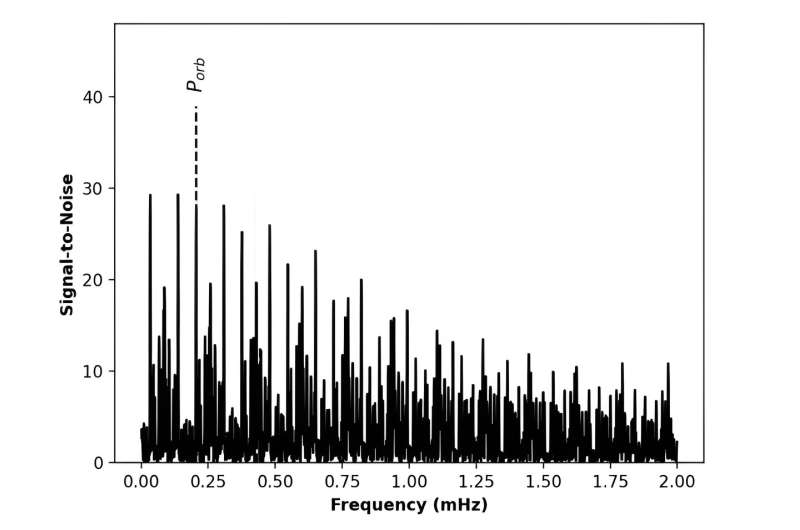October 19, 2023 report
This article has been reviewed according to Science X's editorial process and policies. Editors have highlighted the following attributes while ensuring the content's credibility:
fact-checked
preprint
trusted source
proofread
Cataclysmic variable Swift J0503.7-2819 investigated by researchers

Using various spacecraft and ground-based observatories, an international team of astronomers has performed a multi-wavelength study of a cataclysmic variable system known as Swift J0503.7-2819. Results of the study, published October 11 on the pre-print server arXiv, deliver important insights into the nature of this system.
Cataclysmic variables (CVs) are binary star systems consisting of a white dwarf accreting material from a normal star companion. They irregularly increase in brightness by a large factor, then drop back down to a quiescent state. In some CVs, accretion occurs through a truncated accretion disk when the white dwarf is moderately magnetic. These systems are known as intermediate polars (IPs).
Polars are another subclass of cataclysmic variables that differ from other CVs by the presence of a very strong magnetic field in their white dwarfs. Astronomers also distinguish asynchronous polars (APs)—a subgroup of polars that showcase diminutive asynchronism.
Located some 2,850 light years away, Swift J0503.7-2819 is a CV detected in 2013 that was initially classified as an IP. It has an orbital period of about 4,896 seconds, while its spin period was measured to be 3,932 seconds. Some studies have suggested that Swift J0503.7-2819 may be an asynchronous polar.
In order to disentangle the true nature of Swift J0503.7-2819, a team of astronomers led by Kala G. Pradeep of the Indian Institute of Science Education and Research in Mohali, India, decided to observe it with AstroSat spacecraft in far-ultraviolet and X-rays. Their study was complemented by optical data from the Southern African Large Telescope (SALT) and X-ray data from the ESA's XMM-Newton and NASA's Swift spacecraft.
The study found that Swift J0503.7-2819 has an orbital and spin period of approximately 4,897.66 and 3,932.03 seconds, which is consistent with previous estimates. Therefore, these values confirm that the system is slightly away from synchronism, with an orbital period below the period gap of CVs, which is between two and three hours.
The researchers noted that the spin-orbit period ratio at a level of approximately 0.8 and its hard X-ray luminosity of 250 nonillion erg/s, suggest that Swift J0503.7-2819 is a nearly synchronous magnetic CV—a low-luminosity IP, similar to EX Hya-like systems.
"The system shares many similarities with the growing number of asynchronous 'EX Hya-like' MCVs: high ??/?Ω, an accretion flow not conforming to a purely disk-fed/stream-fed model, low X-ray luminosity and other chimeric characteristics that blur the line between polars and IPs," the authors of the paper explained.
The results of the study point to the existence of accretion structures around the white dwarf in Swift J0503.7-2819. The astronomers assume that the accretion flow in this system is ring-like, with a non-Keplerian ring feeding the accretion stream. They added that the secondary star in Swift J0503.7-2819 likely possesses a weak magnetic moment preventing spin-orbit synchrony and the evolution of this system into a polar.
More information: Kala G. Pradeep et al, A Multi-wavelength Study of Swift J0503.7-2819: a Chimeric magnetic CV, arXiv (2023). DOI: 10.48550/arxiv.2310.07293
Journal information: arXiv
© 2023 Science X Network




















